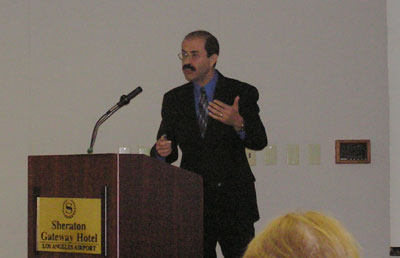Keeping space tourists healthyby Jeff Foust
|
| Medical issues present a business risk to space tourism operators, from the bad publicity associated with an injured or killed passenger to liability lawsuits. |
The FAA’s Office of Commercial Space Transportation (AST) has already made an initial attempt to address those issues. In February 2005 AST issued a document titled “Draft Guidelines for Commercial Suborbital Reusable Launch Vehicle Operations with Space Flight Participants”. The guidelines cover what suborbital space tourism providers should do—but aren’t necessarily required to do—to sure the safety of passengers. The brief guidelines cover issues like informed consent, medical examinations, and training, all at a high level.
Beyond that, though, the guidelines do little to identify specific issues or conditions that would exclude passengers from taking such flights. “So the question really became to us, ‘What is the minimum right stuff for people who want to go to space?’” said Dr. Melchor Antuñano, director of the Civil Aerospace Medical Institute (CAMI). Antuñano, speaking at the International Space Development Conference (ISDC) in Los Angeles in May, said that means trying not to be too specific about medical guidelines and instead using a healthy dose of common sense.
“There is something to be said about common sense,” said Antuñano, who often speaks at length, and passionately, on this topic. “We should to be able to identify those individuals who have certain conditions that could result in inflight death” or force a vehicle to declare an emergency and abort the mission, or otherwise compromise the safety of the other occupants.
Antuñano, though, said that there should be some allowance for those who know that they may be especially susceptible to injury or even death, but want to fly nonetheless. He constructed an example of someone with a terminal disease who wanted to fly despite the enhanced odds of dying on the flight. “Is that right? I would say that, personally, I would want to do that too. As long as it does not compromise the safety of the other crew, why not?”
While the FAA has, for the time being, taken largely a laissez-faire approach to passenger health issues, some are concerned that this will change down the road. Petra Illig, an aerospace medicine doctor in private practice in Alaska who also spoke at the ISDC, said there is a “little bit of a disjoint” right now between medical guidelines for crewmembers versus passengers. Current guidelines recommend that crewmembers have a second-class FAA medical certificate, which Illig said requires only a “pretty minimal” medical exam. Yet passengers, she said, might need additional medical screening and testing for some health conditions. “I find that a little bit interesting.”
Illig believes that the first generation of space tourists will be comprised of “real adventurers” who, along with their families, will be more willing to accept the various risks associated with spaceflight. They will later give way to a second generation that, while initially like the first in terms of their acceptance of risk, will give way to people “who will want to fly as a social status symbol” rather than as an adventure. These people, and their families, will be far less appreciative of the risks associated with spaceflight—opening the door for stricter government regulation when accidents occur.
| “How do we set these medical standards?” Illig asked. “What do we need to do to set standards without exposing companies to unnecessary liability?” |
The industry can protect itself from more stringent government regulations, Illig argued, through self-regulation. “The commercial space industry, in my opinion, should hold themselves to higher standards than what is required by regulators, simply so we can do what is right and do what makes sense, in order to keep the regulators at bay,”she said. “Also, I really strongly feel that this industry should embrace passenger health research.”
This approach, she admits, raises a number of questions that the industry has to answer. “How do we set these medical standards?” she asked. “How do we do research on these passengers? What do we need to do to set standards without exposing companies to unnecessary liability?”
It may be too soon to answer those questions—assuming that the emerging-yet-diverse space tourism industry could even answer those questions in a unified way. However, this is an issue every entrant into this field will have to answer, and in doing will walk a fine line: be too restrictive and a company could fail because it can’t sign up enough passengers; be too permissive and the company could open itself to liability lawsuits and other actions that could prove catastrophic not just to the business, but potentially the entire industry. How companies, passengers, and the government deal with this may be a major factor in the long-term success of suborbital, and eventually orbital, space tourism.
